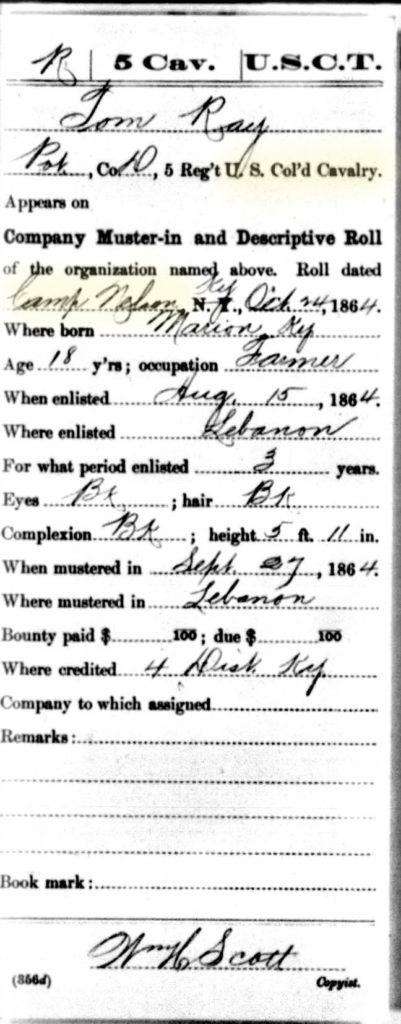Thomas Ray Allen trained at Camp Nelson and must have witnessed and experienced what is described here.
Click to see the video that goes with this audio clip and the excert below – Camp Nelson Heritage Park.
“Eight U.S. colored regiments, as they were called during that time were founded here and three others were trained here. So roughly ten thousand African American men became soldiers at Camp Nelson. In 1864 and 1865. The significance of those recruitments, first of all, was that it was the beginning of the end of slavery in Kentucky. Second of all, these men made a significant contribution to the union victory in the Civil War. A number of regiments were involved in large and small engagements. A number of soldiers were stationed at critical transportation nodes where they protected garrisons, they protected bridges, they protected supply depots.
The Camp Nelson a refugee camp was started in December 1864. And it began, had kind of a mixed beginning because these refugees, who were initially the wives and children of the enlisting U.S. colored troops, were not really supposed to come in the camp, but soldiers brought them them in because they were afraid their owners, former owners would retaliate against them. They also were hoping that the wives and children would also gain their freedom. So, they brought them into camp with them. They set up a lot of shanties throughout the camp. And finally in November 1864, the commander General Speed Fry, ejected all of the refugees from camp. Took them in wagons up towards Nicholasville on a very very cold November day. Many of them were exposed to very cold weather through the night. And out of the four hundred that were ejected, roughly one hundred died within a few weeks of this event. This created a large uproar. And the Army changed their policy. And in December a month later, constructed what they called the come home for colored refugees. Their families, the families of the enlisting soldiers, came to Camp Nelson to escape slavery themselves. They escaped the immediate condition of slavery, and they also hoped to gain their freedom.”

Well this is an interesting and unusual Blog. Have you researched your own ancestors to create this Blog? I saw the movie called Glory on this topic.
CLICK HERE for Bazza’s unimaginable Blog ‘To Discover Ice’
Most of the blog is about my research of my own ancestors. For the A-Z Challenge this year I am using my 2Xgreat uncle Thomas Ray Allen’s USTC pension file and writing posts about people or other things that appeared in the pension file.
The two videos were terrific. I learned a lot from the one about Camp Nelson. What a beautiful place now but it must have been very busy.
I learned a lot from that video. I was glad to find a video so specific to Thomas Ray Allen’s service.
This is a superb post. I have learnt so much from it. The videos were fascinating to see.
Me too.
Whoa. That’s a part of history I did not know about. I wonder if they talk about it in schools… Training ten thousand people on the one hand, and kicking out their escape families on the other… ugh.
The Multicolored Diary: WTF – Weird Things in Folktales
I doubt that they teach it in school. They don’t even want to teach about slavery.
Yeah, I have to echo Zalka’s comments above… to train and rely upon 10,000 soldiers only to kick out their families at their most desperate. I mean, it’s not that different than what most armies do I suppose, and the US army in particular (they still haven’t figured out how to take care of their own veterans). Though I imagine the fact they were “colored” troops only made it much worse…
Sort of amazing there wasn’t an uprising. The families of the white soldiers would have a place to live back on the old home place. They weren’t escaping to what they thought was freedom.
Wow, that’s such an awful way to treat their families. I’m glad to read that they changed the policies afterwards but I can’t imagine anyone deciding to treat other people like that.
Cait @ Click’s Clan
Yes, people can be unimaginably heartless.
This facet of history was certainly new to me, too. Thanks!
Alphabet of Relief Block Printmakers